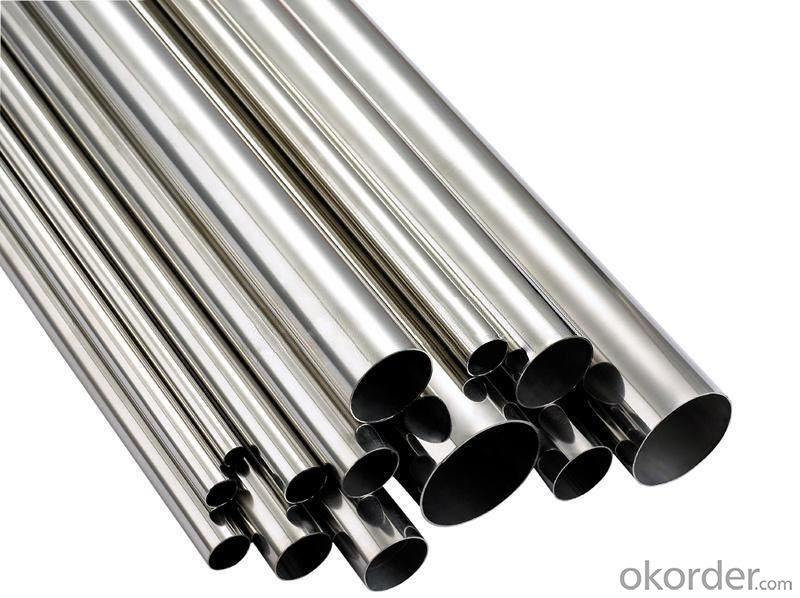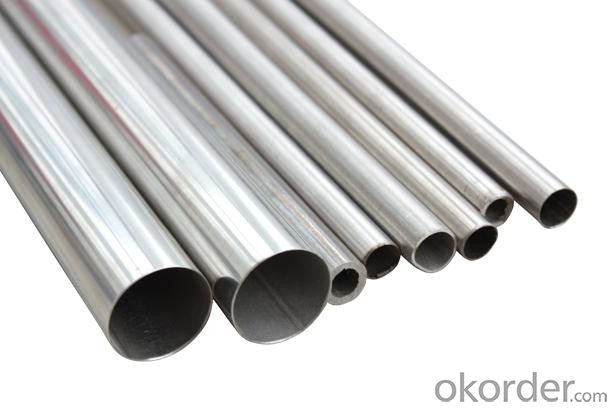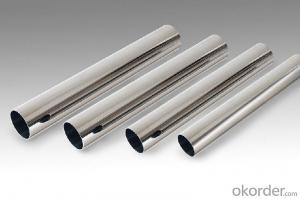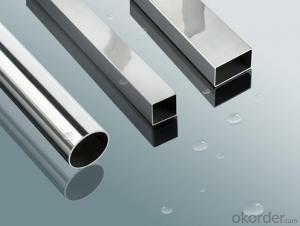Stainless Steel Sanitary Tubing ISO 2037/DIN11850
- Loading Port:
- Ningbo
- Payment Terms:
- TT OR LC
- Min Order Qty:
- 25 m.t.
- Supply Capability:
- 5000 m.t./month
OKorder Service Pledge
OKorder Financial Service
You Might Also Like
1、Structure of Stainless Steel Sanitary Tubing ISO 2037/DIN11850 Description:
Stainless steel sanitary tubing is often used in applications found in the biotech, pharma, and food/beverage industries. Sanitary tubing must be somewhat inert not to react to the chemical that pass through the tubing itself. Sanitary tubing is used in conjunction with stainless sanitary fittings.2、Main Features of the Stainless Steel Sanitary Tubing ISO 2037/DIN11850:
• High manufacturing accuracy
• High strength
• Small inertia resistance
• Good visual effect
•Reasonable price
3、Stainless Steel Sanitary Tubing ISO 2037/DIN11850 Images:



4、Stainless Steel Sanitary Tubing ISO 2037/DIN11850 Specification:
Size:
| Outside diameter | Thickness(mm) | |||||
| (inch) | (mm) | 1 | 1.5 | 2 | 2.5 | 3 |
| 3/4′ | 19.1 | |||||
| 7/8′ | 22.2 | |||||
| 1′ | 25.4 | |||||
| 1-1/8′ | 28.6 | |||||
| 1-1/4′ | 31.8 | |||||
| 1-1/2′ | 38.1 | |||||
| 40 | ||||||
| 45 | ||||||
| 2 | 50.8 | |||||
| 52 | ||||||
| 2-1/4′ | 57.15 | |||||
| 2-1/8′ | 60.3 | |||||
| 2-1/2′ | 63.5 | |||||
| 70 | ||||||
| 3 | 76.2 | |||||
| 85 | ||||||
| 3-1/2′ | 88.9 | |||||
| 4′ | 101.6 | |||||
| 4-1/8′ | 104.78 | |||||
| 4-1/4′ | 107.95 | |||||
| 4-1/2′ | 114.3 | |||||
| 5-1/4′ | 133.35 | |||||
| 6-1/4′ | 158.75 | |||||
| 8-5/8′ | 219.08 | |||||
Tolerances on dimensions table:
| Outside diameter | Thickness | Length | |
| <25.40mm | ±0.13mm | ±10.00% | OD<101.60mm +3.20mm -0mm OD≥101.60mm +4.80 -0mm |
| ≥25.40mm~50.80mm | ±0.20mm | ||
| ≥50.80mm~76.20mm | ±0.25mm | ||
| ≥76.20mm~101.60mm | ±0.38mm | ||
| ≥101.60mm~139.70mm | ±0.38mm | ||
| ≥139.70mm~203.20mm | ±0.76mm | ||
| ≥203.20mm~304.80mm | ±1.27mm | ||
5、FAQ of Stainless Steel Sanitary Tubing ISO 2037/DIN11850:
①How is the quality of your products?
Our products are manufactured strictly according to national and internaional standard, and we take a test on every pipe before delivered out. If you want see our quality certifications and all kinds of testing report, please just ask us for it.
Guaranteed: If products’ quality don’t accord to discription as we give or the promise before you place order, we promise 100% refund.
②How about price?
Yes, we are factory and be able to give you lowest price below market one, and we have a policy that “ for saving time and absolutely honest business attitude, we quote as lowest as possible for any customer, and discount can be given according to quantity”,if you like bargain and factory price is not low enough as you think, just don’t waste your time.Please trust the quotation we would give you, it is professional one.
③Why should you chose us?
Chose happens because of quality, then price, We can give you both.Additionally, we can also offer professional products inquiry, products knowledge train(for agents), smooth goods delivery, exellent customer solution proposals.Our service formula: good quality+good price+good service=customer’s trust
SGS test is available, customer inspection before shipping is welcome, third party inspection is no problem.
Any question, pls feel free to contact us !
- Q:Can stainless steel pipes be used for heat recovery systems?
- Indeed, heat recovery systems can utilize stainless steel pipes. The utilization of stainless steel in heat recovery systems is widespread owing to its remarkable characteristics of heat resistance and corrosion resistance. It can endure elevated temperatures without warping or deteriorating, rendering it apt for the transmission of heat from one medium to another. Moreover, stainless steel pipes boast an extended lifespan and necessitate minimal upkeep, thus presenting a robust and economical alternative for heat recovery systems.
- Q:What factory uses industrial stainless steel tube to be more?
- The electric power industry including nuclear power industry, the demand for stainless steel tube is large, the industry mainly uses the stainless steel seamless pipe, specific application fields: boiler pipes, water pipes, power tubes etc..According to the World Nuclear Association reports, China has 5 power stations under construction, 6 included in the plan, 19 are planning, it is estimated that power plant construction and maintenance of various types of stainless steel pipes each year about 25600 tons.
- Q:How do stainless steel pipes differ from other types of pipes?
- Stainless steel pipes differ from other types of pipes primarily due to their corrosion-resistant properties, which make them highly durable and long-lasting. Unlike other pipes, stainless steel pipes are less prone to rusting or corroding, making them suitable for a wide range of applications, particularly in industries where hygiene and cleanliness are essential. Additionally, stainless steel pipes have high strength and heat resistance, making them capable of withstanding extreme temperatures and pressures, making them a preferred choice for various industrial and commercial applications.
- Q:Can stainless steel pipes be etched?
- Yes, stainless steel pipes can be etched. Etching is a process of removing a thin layer of metal from the surface of the pipe to create a desired design or pattern. This is typically done using an acid or chemical solution that selectively dissolves the exposed metal. However, it is important to note that not all grades of stainless steel are equally suitable for etching. Austenitic stainless steels, such as 304 and 316, are commonly used for etching due to their corrosion resistance and ease of etching. Other factors that can influence the etching process include the composition and thickness of the stainless steel, as well as the etching method and conditions used.
- Q:Can stainless steel pipes be used for sewage pumping stations?
- Indeed, sewage pumping stations can utilize stainless steel pipes. Renowned for their resistance to corrosion, stainless steel proves to be an optimal material for sewage and wastewater applications. These pipes exhibit durability and strength, enabling them to endure the challenging circumstances and corrosive components present within sewage systems. Moreover, stainless steel exemplifies hygienic qualities and simplicity in cleaning, vital aspects for upholding the sanitation and effectiveness of a sewage pumping station. Consequently, stainless steel pipes establish themselves as a dependable and enduring selection for sewage pumping stations.
- Q:What is the difference between seamless and cold-rolled stainless steel pipes?
- The main difference between seamless and cold-rolled stainless steel pipes lies in their manufacturing process and the resulting characteristics. Seamless stainless steel pipes are produced by piercing a solid cylindrical billet of stainless steel and then processing it through various steps such as elongation and reduction to achieve the desired size and shape. This process ensures that the pipe has a smooth and even surface, without any welded seams. As a result, seamless stainless steel pipes exhibit superior strength, durability, and resistance to corrosion. They are also known for their ability to withstand high pressure and temperature conditions, making them suitable for a wide range of applications, including oil and gas pipelines, chemical processing, and power generation. On the other hand, cold-rolled stainless steel pipes are manufactured by rolling stainless steel sheets or strips at room temperature. This process involves passing the material through a series of rollers to reduce its thickness and shape it into a cylindrical form. Unlike seamless pipes, cold-rolled pipes have welded seams that may be visible on the surface. While these seams can potentially weaken the pipe, they can be mitigated by applying additional processes such as heat treatment or cold working to enhance the strength and integrity of the weld. The choice between seamless and cold-rolled stainless steel pipes depends on the specific requirements of the application. Seamless pipes are generally preferred when high strength, corrosion resistance, and pressure resistance are critical, especially in industries where leaks or failure can have severe consequences. Cold-rolled pipes, on the other hand, may be more suitable for applications where cost-effectiveness and moderate performance are sufficient, such as certain plumbing systems or decorative purposes. In summary, seamless stainless steel pipes are produced without welded seams, offering superior strength, durability, and resistance to corrosion, making them ideal for demanding applications. Cold-rolled stainless steel pipes, with visible welded seams, are generally more cost-effective and suitable for less demanding applications that don't require the same level of strength and corrosion resistance.
- Q:What are stainless steel pipes used for?
- Stainless steel pipes are commonly used in various industries and applications due to their durability, corrosion resistance, and high strength. They are primarily used for transporting fluids and gases such as water, oil, gas, and chemicals. Additionally, stainless steel pipes find extensive use in plumbing systems, construction projects, automotive applications, food processing plants, pharmaceutical industries, and manufacturing processes where hygiene, reliability, and longevity are crucial.
- Q:Where is the difference between seamless steel pipe and welded pipe?
- 1., the appearance of seamless steel pipe and welded pipe difference in the welded pipe wall welded tendons, and seamless No.2. seamless pipe pressure is higher, welded pipe is generally in 10 or so MPa, now welded pipe to do seamless processing.
- Q:What is the difference between electropolished and mechanically polished stainless steel pipes?
- The main difference between electropolished and mechanically polished stainless steel pipes lies in the method used to achieve the desired surface finish. Electropolishing involves immersing the pipe in an electrolyte solution and applying an electric current, which removes a thin layer of metal and impurities, resulting in a smooth, clean, and corrosion-resistant surface. On the other hand, mechanical polishing involves abrasive materials, such as sandpaper or polishing wheels, to physically remove imperfections and create a smooth surface. Both methods can enhance the aesthetics and performance of stainless steel pipes, but electropolishing offers superior cleanliness, corrosion resistance, and a more uniform finish.
- Q:Are stainless steel pipes suitable for wastewater treatment ponds?
- Stainless steel pipes are indeed appropriate for wastewater treatment ponds. Due to their exceptional resistance to corrosion, stainless steel proves to be an ideal material for managing wastewater, which can be incredibly corrosive. The robustness and sturdiness of stainless steel pipes enable them to endure the severe conditions and chemicals present in wastewater treatment ponds. Furthermore, stainless steel pipes are effortless to clean and upkeep, guaranteeing the efficacy and efficiency of wastewater treatment procedures. All things considered, stainless steel pipes emerge as a dependable and enduring alternative for wastewater treatment ponds.
1. Manufacturer Overview |
|
|---|---|
| Location | |
| Year Established | |
| Annual Output Value | |
| Main Markets | |
| Company Certifications | |
2. Manufacturer Certificates |
|
|---|---|
| a) Certification Name | |
| Range | |
| Reference | |
| Validity Period | |
3. Manufacturer Capability |
|
|---|---|
| a)Trade Capacity | |
| Nearest Port | |
| Export Percentage | |
| No.of Employees in Trade Department | |
| Language Spoken: | |
| b)Factory Information | |
| Factory Size: | |
| No. of Production Lines | |
| Contract Manufacturing | |
| Product Price Range | |
Send your message to us
Stainless Steel Sanitary Tubing ISO 2037/DIN11850
- Loading Port:
- Ningbo
- Payment Terms:
- TT OR LC
- Min Order Qty:
- 25 m.t.
- Supply Capability:
- 5000 m.t./month
OKorder Service Pledge
OKorder Financial Service
Similar products
New products
Hot products
Hot Searches
Related keywords





























